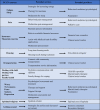Evolution of a longitudinal, multidisciplinary, and scalable patient navigation matrix model
- PMID: 32129946
- PMCID: PMC7196067
- DOI: 10.1002/cam4.2950
Evolution of a longitudinal, multidisciplinary, and scalable patient navigation matrix model
Abstract
This Longitudinal patient navigation Matrix Model was developed to overcome barriers across the cancer care continuum by offering prepatients, patients, and their families with support services. The extraordinary heterogeneity of patient needs during cancer screening, risk assessment, treatment, and survivorship as well as the vast heterogeneity of oncology care settings make it nearly impossible to follow a static navigation model. Our model of patient cancer navigation is unique as it enhances the traditional model by being highly adaptable based on both patient and family needs and scalable based on institutional needs and resources (eg, clinical volumes, financial resources, and community-based resources). This relatively new operational model for system-wide and systematic navigation incorporates a carefully cultivated supportive care program that evolved over the last decade from a bottom up approach that identified patient and family needs and developed appropriate resources. A core component of this model includes shifting away from department-centric operations. This model does not require a patient to opt in or independently be able to report their needs or ask for services-it is an opt out model. The multidisciplinary "cross-training" model can also facilitate reimbursement and sustainability by clarifying the differentiating actions that define navigation services: identification of barriers to quality care and specific actions taken to overcome those barriers, across the full continue of cancer care from community engagement to survivorship or end-of-life care.
Keywords: patient navigation.
© 2020 The Authors. Cancer Medicine published by John Wiley & Sons Ltd.
Conflict of interest statement
The authors SRP and CC have received funding from AstraZeneca for “Digital Innovation in Supportive Care.”
Figures



References
-
- Freeman HP. The origin, evolution, and principles of patient navigation. Cancer Epidemiol Biomark Prev. 2012;21(10):1614‐1617. - PubMed
-
- Patierno SR, LaVerda NL, Alexander LM, Levine PH, Young HA, Hoffman HJ. Longitudinal network patient navigation. Oncology Issues. 2010;25(2):28‐35.
Publication types
MeSH terms
LinkOut - more resources
Full Text Sources
Medical

